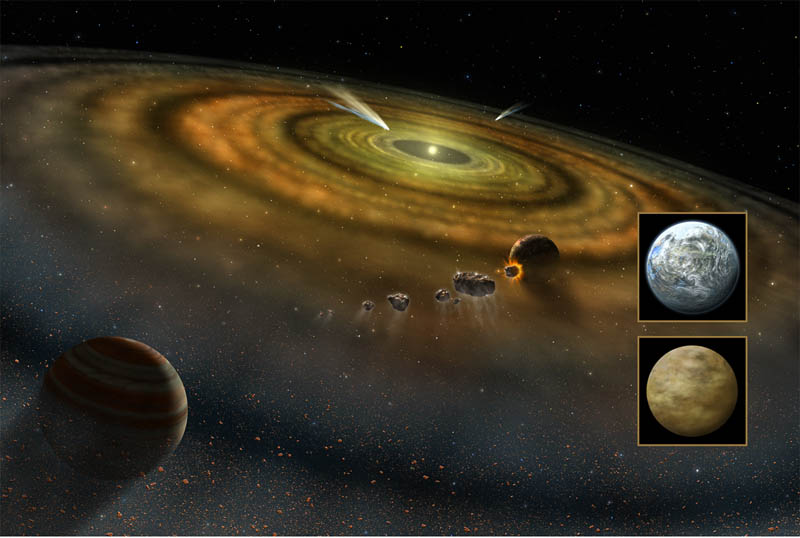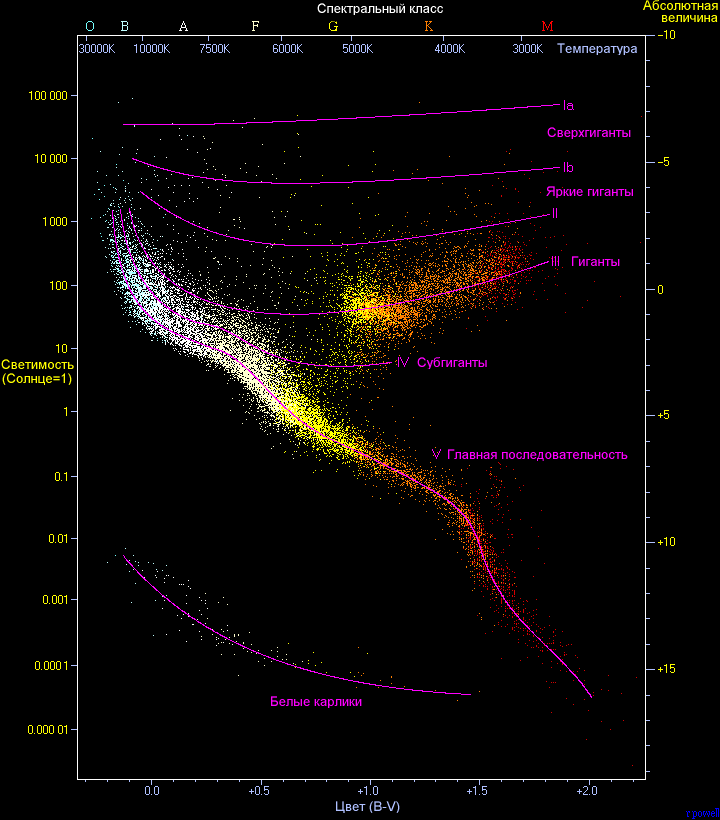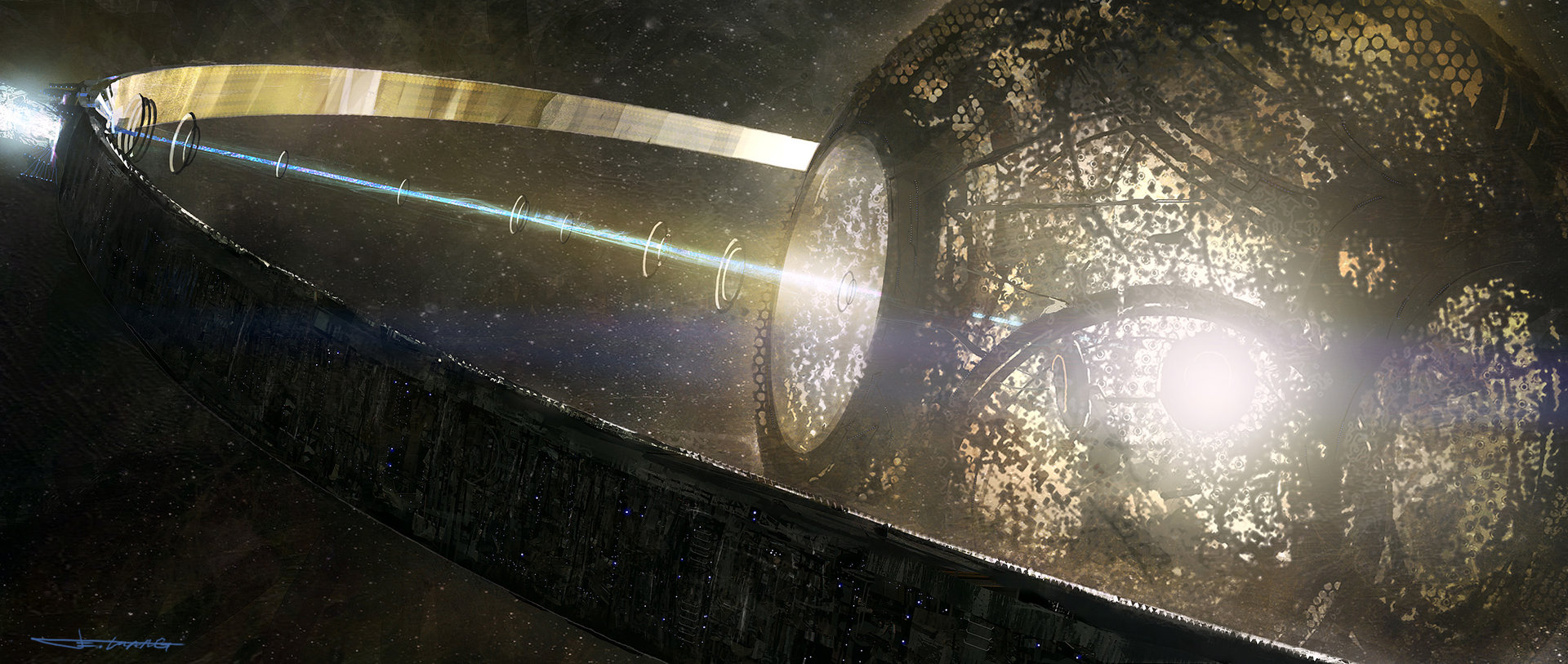There is no exceptional evidence of a Dyson Sphere in orbit KIC 8462852
from the translator: this time, an article from a skeptical scientist on this star.
On October 17, 2015, Tubeta Boyadzhin et al. Published a preprint of their publication in the astronomy and astrophysics scientific journal " Monthly Notices of the Royal Astronomical Society " under the heading " Planet Hunters 10. KIC 8462852 - On the Density of Flow ", in which they described an unusual curve in detail the luminosity of the star KIC 8462852 . Send the speculation that this is due to some Sphera Dyson.

The exocomets and various emerging planets around Beta Painter, a very young star of class A of the Main sequence. (NASA, artist concept).
')
First, let's look at the characteristics of this star. KIC 8462852 is a F3 spectral-type star with a photosphere temperature of approximately 6,750 Kelvin (for comparison, our Sun has a temperature of 5,800 Kelvin).
from the translator: please write about errors / typos in PM. Thank!
It appears that this is the star of the Main sequence approaching the end of its lifetime on the Main sequence. Similar stars have been on the Main sequence for about 4.5 billion years; almost half as much as expected for our Sun, which is a G2 star. Thus, if our civilization existed on a planet orbiting this star, we would have to leave its neighborhood, because now it would be the end of her life on the Main sequence and the beginning of the road to oblivion. By the way, KIC 8462852 is about 1480 light-years away.

Hertzsprung - Russell Chart
In their work in 2015, Boyadzhin with co-authors discuss analyzes of the luminosity curve recorded by the NASA Kepler telescope. They report the detection of anomalous "drops in flux density up to 20%." It should be noted that this, of course, is not the only stellar object detected by the Kepler telescope, which demonstrates an unusual luminosity curve. Bryce Kroll and co- workers in 2015 noted the anomalous luminosity of the star WD 1145 + 017 . In short, with regard to KIC 8462852, scientists agreed that the unusual luminosity is caused by “passing a family of exocomet fragments.
So, we have a scientific analysis of the unusual finding of the NASA Kepler apparatus. Many colleagues accessed data on these findings and one group reviewed an alternative explanation for the anomalous data. This team, led by Jason Wright of the University of Pennsylvania, offered a different explanation for the data. Wright and colleagues at work in 2015 suggested that unusual data is explained by the Dyson Sphere built by an extraterrestrial civilization. Similar luminosity curves have actually been predicted by others, including Luke Arnold ( work 2005 ), Duncan Forgan ( work 2013 ), and Eric Korpel with colleagues ( work 2015 ).

On October 15, Wright and his colleagues sent their work entitled “ Search for extraterrestrial civilizations with high energy consumption, part 4. Traces and informational content of the walkways [on the star disk] mega constructions ” for consideration for publication in the Astrophysical Journal . ” In their work, Wright and colleagues argue that such luminosity indicators for the star KIC 8462852 are “an extraordinary goal for SETI ”. The authors also propose two other candidates for further study: KIC 12557548 and CoRoT-29 .
What Wright and his colleagues did was to offer an alternative explanation for the anomalous data from the star KIC 8462852. There is nothing unusual in such proposals of various hypotheses to explain the observations; this is how science works. Unfortunately, in our time of instant messaging and social media, Wright’s hypothesis became viral on the Internet and was picked up by popular publications with an almost complete silence about another, more verified, hypothesis, Boyagin and her colleagues.
David Kupcell in his article “ From N-rays to EmDrive: When does science become pseudoscience? “Clarifies the difference between science and pseudoscience. Cucell summarizes the difference by stating that "a hypothesis is pseudoscientific if and only if it is unfalsifiable." Also, he argues that "any hypothesis that can logically be refuted by any experiment is scientific."
If we apply the “Razor Cupella” to the case of data from KIC 8462852, what will we see? The proposed hypotheses are distinguished by the fact that in astronomy it is usual to not be able to carry out any experiments. The only option is observation. There is one point that is mentioned by all the authors of these publications - everyone agrees that it is necessary to conduct more observations in order to establish which hypothesis best explains the unusual data. Simply put, we need more data before making any conclusions. Indeed, this is how science is done. The first event, which concerns the possible detection of life on Mars, was associated with the landing module of the Viking spacecraft , which was written by Harold Soffen (in 1977) and Harold Geller [ by this article - lane] (in 2014).
In particular, there was a case with apparently positive results of biological experiments, when at the same time the gas chromatography-mass spectrometer showed the complete absence of any organic molecules. The team involved in the Viking landing module concluded (not unanimously) that biological experiments actually reacted to unusual chemical compounds present on surfaces with a high content of peroxides and supraperoxides.
Another example of the Viking Mars program was two photos taken by the Viking Orbital Module, which later became known as the Face on Mars .

A small part of the Cydonia region, taken by the Viking 1 device and published by NASA's Jet Propulsion Laboratory on July 25, 1976.
In this case, the media also picked up the most provocative explanation for such a plateau - supposedly these are traces of the Martian civilization. This hypothesis of the origin of the plateau brought some people fame and fortune. Unfortunately for supporters of this idea, after the filming of Mars with the Mars Global Surveyor apparatus 20 years later, this hypothesis was excluded from the field of science. Of course, she is still alive in “cyberspace”, where any pseudoscience is supported.
In 1996, Mars was again reported about the discovery of signs of life ( David McKay publication, 1996 [pdf] ). This time in a meteorite, about which there was strong evidence of its origin from Mars. The meteorite ALH84001 was discovered in the region of Allan Hills, Antarctica in 1984. It was determined that the meteorite should occur from the planet Mars. Further analysis of meteorite samples led some to conclude that there are microscopic traces of fossil remains. Nevertheless, the following years gave more evidence in favor of the fact that, despite the reality of origin from Mars, still does not contain evidence of life (the work of Edward Scott with colleagues from 1997 and David Barber and Edward Scott from 1997 ).

Meteorite ALH84001 in the Smithsonian Museum of Natural History.
"Unusual statements require serious evidence" - a phrase that made Karl Sagan popular in his book Cosmos (1980) and in the documentary series of the same name. Nevertheless, historically this statement was made by David Hume in 1748 by Pierre-Simon Laplace in 1812 and Marcello Truzzi in 1978. In the same light, Sir Arthur Conan Doyle, in the guise of Sherlock Holmes, taught the world: "Drop all that is impossible; what remains will be the answer, no matter how incredible it may seem."
There are still alternative explanations for the anomalous data received from KIC 8462852, which, so far, have not been discarded from the field of the possible.
Do you believe that this evidence is serious enough to confirm the unusual hypothesis that such a luminosity curve is explained by the Dyson Sphere? I do not think so.
Harold A. Geller, DA
Director of the Observatory and Associate Professor at George Mason University, Fairfax, Va.
On October 17, 2015, Tubeta Boyadzhin et al. Published a preprint of their publication in the astronomy and astrophysics scientific journal " Monthly Notices of the Royal Astronomical Society " under the heading " Planet Hunters 10. KIC 8462852 - On the Density of Flow ", in which they described an unusual curve in detail the luminosity of the star KIC 8462852 . Send the speculation that this is due to some Sphera Dyson.

The exocomets and various emerging planets around Beta Painter, a very young star of class A of the Main sequence. (NASA, artist concept).
')
First, let's look at the characteristics of this star. KIC 8462852 is a F3 spectral-type star with a photosphere temperature of approximately 6,750 Kelvin (for comparison, our Sun has a temperature of 5,800 Kelvin).
from the translator: please write about errors / typos in PM. Thank!
It appears that this is the star of the Main sequence approaching the end of its lifetime on the Main sequence. Similar stars have been on the Main sequence for about 4.5 billion years; almost half as much as expected for our Sun, which is a G2 star. Thus, if our civilization existed on a planet orbiting this star, we would have to leave its neighborhood, because now it would be the end of her life on the Main sequence and the beginning of the road to oblivion. By the way, KIC 8462852 is about 1480 light-years away.

Hertzsprung - Russell Chart
In their work in 2015, Boyadzhin with co-authors discuss analyzes of the luminosity curve recorded by the NASA Kepler telescope. They report the detection of anomalous "drops in flux density up to 20%." It should be noted that this, of course, is not the only stellar object detected by the Kepler telescope, which demonstrates an unusual luminosity curve. Bryce Kroll and co- workers in 2015 noted the anomalous luminosity of the star WD 1145 + 017 . In short, with regard to KIC 8462852, scientists agreed that the unusual luminosity is caused by “passing a family of exocomet fragments.
So, we have a scientific analysis of the unusual finding of the NASA Kepler apparatus. Many colleagues accessed data on these findings and one group reviewed an alternative explanation for the anomalous data. This team, led by Jason Wright of the University of Pennsylvania, offered a different explanation for the data. Wright and colleagues at work in 2015 suggested that unusual data is explained by the Dyson Sphere built by an extraterrestrial civilization. Similar luminosity curves have actually been predicted by others, including Luke Arnold ( work 2005 ), Duncan Forgan ( work 2013 ), and Eric Korpel with colleagues ( work 2015 ).

On October 15, Wright and his colleagues sent their work entitled “ Search for extraterrestrial civilizations with high energy consumption, part 4. Traces and informational content of the walkways [on the star disk] mega constructions ” for consideration for publication in the Astrophysical Journal . ” In their work, Wright and colleagues argue that such luminosity indicators for the star KIC 8462852 are “an extraordinary goal for SETI ”. The authors also propose two other candidates for further study: KIC 12557548 and CoRoT-29 .
What Wright and his colleagues did was to offer an alternative explanation for the anomalous data from the star KIC 8462852. There is nothing unusual in such proposals of various hypotheses to explain the observations; this is how science works. Unfortunately, in our time of instant messaging and social media, Wright’s hypothesis became viral on the Internet and was picked up by popular publications with an almost complete silence about another, more verified, hypothesis, Boyagin and her colleagues.
David Kupcell in his article “ From N-rays to EmDrive: When does science become pseudoscience? “Clarifies the difference between science and pseudoscience. Cucell summarizes the difference by stating that "a hypothesis is pseudoscientific if and only if it is unfalsifiable." Also, he argues that "any hypothesis that can logically be refuted by any experiment is scientific."
If we apply the “Razor Cupella” to the case of data from KIC 8462852, what will we see? The proposed hypotheses are distinguished by the fact that in astronomy it is usual to not be able to carry out any experiments. The only option is observation. There is one point that is mentioned by all the authors of these publications - everyone agrees that it is necessary to conduct more observations in order to establish which hypothesis best explains the unusual data. Simply put, we need more data before making any conclusions. Indeed, this is how science is done. The first event, which concerns the possible detection of life on Mars, was associated with the landing module of the Viking spacecraft , which was written by Harold Soffen (in 1977) and Harold Geller [ by this article - lane] (in 2014).
In particular, there was a case with apparently positive results of biological experiments, when at the same time the gas chromatography-mass spectrometer showed the complete absence of any organic molecules. The team involved in the Viking landing module concluded (not unanimously) that biological experiments actually reacted to unusual chemical compounds present on surfaces with a high content of peroxides and supraperoxides.
Another example of the Viking Mars program was two photos taken by the Viking Orbital Module, which later became known as the Face on Mars .

A small part of the Cydonia region, taken by the Viking 1 device and published by NASA's Jet Propulsion Laboratory on July 25, 1976.
In this case, the media also picked up the most provocative explanation for such a plateau - supposedly these are traces of the Martian civilization. This hypothesis of the origin of the plateau brought some people fame and fortune. Unfortunately for supporters of this idea, after the filming of Mars with the Mars Global Surveyor apparatus 20 years later, this hypothesis was excluded from the field of science. Of course, she is still alive in “cyberspace”, where any pseudoscience is supported.
In 1996, Mars was again reported about the discovery of signs of life ( David McKay publication, 1996 [pdf] ). This time in a meteorite, about which there was strong evidence of its origin from Mars. The meteorite ALH84001 was discovered in the region of Allan Hills, Antarctica in 1984. It was determined that the meteorite should occur from the planet Mars. Further analysis of meteorite samples led some to conclude that there are microscopic traces of fossil remains. Nevertheless, the following years gave more evidence in favor of the fact that, despite the reality of origin from Mars, still does not contain evidence of life (the work of Edward Scott with colleagues from 1997 and David Barber and Edward Scott from 1997 ).

Meteorite ALH84001 in the Smithsonian Museum of Natural History.
"Unusual statements require serious evidence" - a phrase that made Karl Sagan popular in his book Cosmos (1980) and in the documentary series of the same name. Nevertheless, historically this statement was made by David Hume in 1748 by Pierre-Simon Laplace in 1812 and Marcello Truzzi in 1978. In the same light, Sir Arthur Conan Doyle, in the guise of Sherlock Holmes, taught the world: "Drop all that is impossible; what remains will be the answer, no matter how incredible it may seem."
There are still alternative explanations for the anomalous data received from KIC 8462852, which, so far, have not been discarded from the field of the possible.
Do you believe that this evidence is serious enough to confirm the unusual hypothesis that such a luminosity curve is explained by the Dyson Sphere? I do not think so.
Harold A. Geller, DA
Director of the Observatory and Associate Professor at George Mason University, Fairfax, Va.
Source: https://habr.com/ru/post/366861/
All Articles